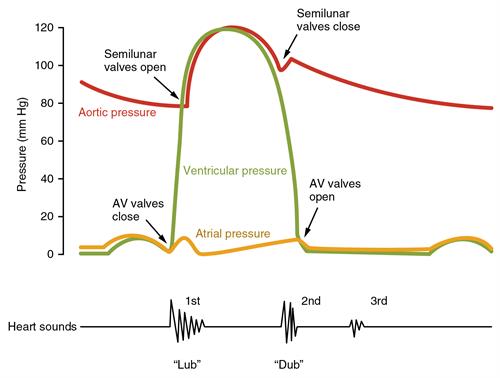
PUMPA - SMART LEARNING
எங்கள் ஆசிரியர்களுடன் 1-ஆன்-1 ஆலோசனை நேரத்தைப் பெறுங்கள். டாப்பர் ஆவதற்கு நாங்கள் பயிற்சி அளிப்போம்
Book Free DemoThe sequence of events occurring from the beginning to the completion of one heartbeat is called the cardiac cycle.
The cardiac cycle consists of one cycle of contraction and relaxation of cardiac muscle. During a heartbeat, there is contraction and relaxation of the atria and ventricles. During the cardiac cycle, the blood flows through the chambers of the heart in a specific direction. Each cardiac cycle lasts about 0.8 seconds.
The contraction phase is called the systole, and the relaxation phase is called the diastole. The stages of the cardiac cycle are discussed briefly below:
1. Atrial systole:
The auricles contract due to a wave of contraction stimulated by the SA node. The bicuspid and tricuspid valves open, forcing blood into the ventricles. The atrial systole duration lasts for 0.1 seconds.
2. Ventricular systole:
Ventricles contract due to a wave of contraction, which is stimulated by the SA node. Bicuspid and tricuspid valves close immediately, producing the first heart sound. The outflow of blood is first rapid from the ventricles, which slows down at the end.
When the ventricles complete their contraction, the blood flows into the pulmonary trunk and aorta as the semilunar valves open. The duration of ventricular systole is 0.3 seconds.
3. Atrial diastole:
Relaxation of atria occurs during which the atria fill blood from the vena cavae. The atrial diastole lasts for 0.7 seconds.
4. Ventricular diastole:
Relaxation of ventricles occurs, and the semilunar valves close. Next, the tricuspid and bicuspid valves open, and blood flows from the atria into the ventricles. The ventricular diastole lasts for 0.3 seconds.

Cardiac cycle
Heart sound:
The rhythmic closure and opening of the valves cause the sound of the heart.
The first sound LUBB is low pitched and of longer duration. It is produced by the closure of the bicuspid and tricuspid valves after the beginning of ventricular systole.
The second sound DUPP is highly pitched, louder and of shorter duration. It is produced by the closure of semilunar valves at the end of the ventricular systole.

Sounds of heart
A video demonstrating the cardiac cycle:
Reference:
https://upload.wikimedia.org/wikipedia/commons/c/c1/Phases_of_the_cardiac_cycle.svg
https://upload.wikimedia.org/wikipedia/commons/f/f3/2029_Cardiac_Cycle_vs_Heart_Sounds.jpg
https://www.youtube.com/watch?v=RYZ4daFwMa8